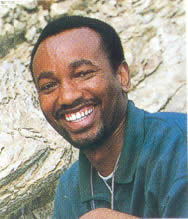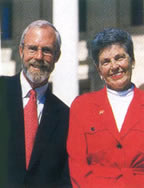INVESTING IN OUR STUDENTS
Hoping to attract talented
and diverse students by increasing scholarship opportunities, the University
of Utah has launched a three-year $25 million endowment campaign for scholarship
funds, a move that is unique among universities. Most university fund-raising
campaigns support broad-based programs, but rarely is a campaign solely
designed to attract students with merit- and need-based awards. “We’re
setting the standard nationally,” says Barbara Snyder, vice president
for student affairs.
“A college degree continues to be an unattainable goal for many young
people who have incredible potential,” says U President Bernie Machen.
“We must provide the needed scholarships to recruit the best students,
to reward academic excellence, to foster opportunities for those with
diverse backgrounds, and to provide enriched learning opportunities in
the classroom and beyond.”
Scholarships are the tools to do just that. They free students to focus
on studies, minimize financial concerns, expand educational ambitions,
provide an impetus to work harder and demonstrate excellence, raise self-esteem,
and allow for time to participate in campus and community activities.
Scholarships can offer access to higher education to students who otherwise
would not be able to attend a college or university.
|
“Nowhere are our resources better spent than in educating students,” agrees Sue D. Christensen BS’56, co-chair of the Scholarship Campaign with Phillip W. Clinger BS’67. Both are members of the U of U National Advisory Council, and they will lead a team of volunteers including Thomas D. “Tim” Dee III MBA’77, David E. Salisbury BS’49, and Judith Burton Moyle BA’67. |
 Patrick Nduru Gathogo |
Scholarship recipient Patrick Nduru Gathogo BS’01 of Kenya is one of many students who would not have been able to attend the U without a scholarship. As a geology undergraduate at Kenya Polytechnic, he participated in fieldwork with paleoanthropologist Maeve Leakey of the National Museums of Kenya. It was in the field with Leakey that Gathogo met Frank Brown, dean of the U’s College of Mines and Earth Sciences. Thanks to a U of U geology department award, Gathogo was able to get a uni-versity education and participate in the extraordinary field discovery of a 3.5 million-year-old fossilized skull. The finding brought international attention to Gathogo, Leakey, and Brown.
A geologist’s job is
to date fossils based on the age of the surrounding land. Brown and Gathogo
spotted an area rich in undisturbed fossils and suggested that fossil
hunters look there. Meanwhile, the geologists began tracing a nearby layer
of volcanic ash, trying to pinpoint the age of the new fossil bed and
to estimate the new discovery’s age.
“The dating of this skull, Kenyanthropus platyops, means that the
line of man’s descent is no longer so clear,” says Brown. “When
the partial skeleton known as Lucy was found in Ethiopia in 1974, many
researchers believed her species, Australopithecus afarensis, was the
ancestor of modern humans. Now that we have a new form of early hominid
from the same time period that is quite distinct from Lucy, the anthropologists
will have to determine which of the two creatures actually lies in our
ancestral tree. It cannot be both; one of the lineages survived and evolved,
the other died off.”
“Without the scholarship,” says Gathogo, “I would not have been part of this exciting discovery. I will always be thankful for this incredible opportunity and the great start it has given to my career.”

